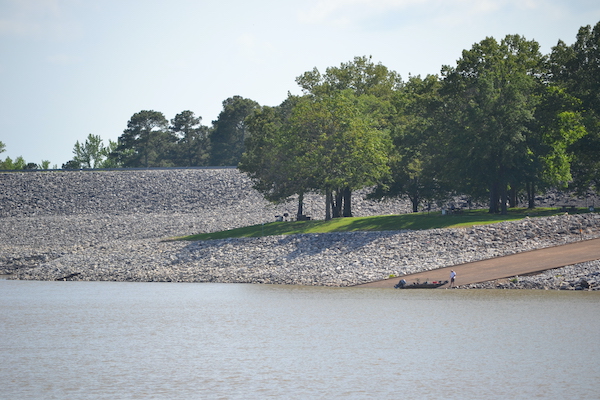Hydropower Ahead for Mississippi, Sardis Dam on the List
Published 9:24 am Thursday, June 13, 2024

- Sardis Lake is a favorite spot for local fishermen. Photo by Hal Fox.
By Hal Fox
UM journalism student
Mississippi is one of only two states in the country with no hydropower infrastructure. That is about to change.
In 2016, the Mississippi Army Corps of Engineers released plans to retrofit four dams across Mississippi and turn them into hydroelectric power plants. One of those hydroelectric plants will be located at Sardis Lake, just a 20-minute drive away from Oxford.
Construction has not begun, according to a spokesperson for Rye Development, the company the Corps contracted for the project, which specializes in retrofitting dams for hydroelectric power generation.
“Sardis is currently in the design phase of development,” Vice President of Rye Development Michael Rooney said. “In addition to completing design and engineering, we’re actively pursuing the required power purchase agreement to enable project construction.”
The power purchase agreement will determine the rate and price that Rye Development sets for the energy generated from the new hydroelectric plants, which it plans to sell to the government. While the dam itself still belongs to the state, the hydropower plant will be owned and operated by Rye.
Andrew Tomlinson, the Mississippi Valley Division hydropower manager for the Army Corps of Engineers, explained how the project will be managed once it is constructed.
Trending
“The Corps will not have any responsibilities for operations or maintenance of the project once it is constructed,” Tomlinson said. “Rye Development will own and operate the facility.”
Of course, the project must meet engineering standards laid out by the Army Corps of Engineers.
“The Corps has the requirement to review the plans and specifications and make sure that they are up to all of the Corps’ internal standards as well as all other engineering body standards,” Tomlinson said.
A 2021 publication from the Mississippi Public Service Commission Central District Office said that the four hydro projects in Mississippi will produce an estimated 119,400 megawatt hours of electricity every year, enough to power around 11,000 homes. According to Rye Development, the Sardis Lake project will contribute about half of that power generation.
“The project is expected to produce 52 gigawatt hours annually, translating to renewable hydropower energy for approximately 4,837 homes every year throughout the project’s lifespan,” Rooney said.
Hydroelectric Power Explained
Jonah Jurss is a professor of chemistry and biochemistry at the University of Mississippi specializing in renewable energy research. His research group, the Jurss Laboratory, is working to develop chemical fuels from renewable energy sources like water and sunlight. He explained the basic process by which hydroelectric power plants convert the movement of water into electricity.
“Hydroelectric dams generate power by converting the potential energy of water at a higher elevation into mechanical energy which is then used to generate electrical energy. Water that has accumulated behind a dam has potential energy,” Jurss said. “The amount of potential energy depends on the height the water will fall when going through the dam to a point of lower elevation and the volume of water that can pass through the dam when the gates are open. With the dam gates open, the falling water has mechanical energy that spins the blades of a turbine, which causes electromagnets to rotate within stationary coils of wire that generate electricity.”
These dams must be placed in valleys where the rushing water has its highest potential energy in order to maximize power generation. Of course, constructing a dam can also have unintended consequences to the natural environment.
“There are environmental impacts associated with disrupting the natural flow of water, covering large amounts of land with water when the lake is formed, how many people the resulting lake will displace,” Jurss said. “River habitats are lost, fish migration patterns are disrupted, and this affects the entire ecosystem of the area near the dam as well as down river. On the other hand, dams can provide clean, renewable energy for years to come which is beneficial to the environment; they create recreational lakes and can be important tools for flood control.”
The projects undertaken by Rye Development in Mississippi are on dams already constructed, however, so Jurss sees them as a net positive for the state.
“Existing dams associated with lakes Enid, Grenada, Sardis and Arkabutla will be upgraded to hydroelectric dams. So, in this case, I would say it is a very good thing to now be able to use these lakes to produce hydroelectricity,” Jurss said. “It is unlikely that the dams would be removed to restore the natural flow of water, so whatever the pros and cons were when the dams were initially constructed, decisions were made. Now the dams/lakes can provide the additional benefit of producing clean electricity. That benefits all of us.”
The Unknowns
One potential issue with the development, however, is the current condition of the dam. Lafayette County has 12 dams that are rated in “poor” or “unsatisfactory” condition, while neighboring Panola County has seven. A “poor” rating means that a potential safety issue has been identified, requiring further investigation. An “unsatisfactory” rating means that the dam requires immediate action to address a safety deficiency. While some of these low-rated dams are privately owned, the majority are owned and operated by local governments.
“The Corps has a variety of inspections that are required on various cycles. The main one is the periodic inspection (five years),” Tomlinson said. “The last PI (for Sardis Dam) was performed in 2022.”
The hazard potential classification for Sardis Dam is rated as “high,” meaning that should the dam give out, it would lead to a large loss of life and property. In a document from the Army Corps of Engineers that briefly outlines plans for the Mississippi hydroelectric retrofitting project undertaken by Rye Development, the Dam Safety Action Classifications (DSAC) for projects at Enid, Arkabutla, Grenada and Sardis Lakes are redacted.





